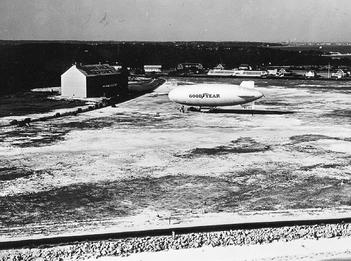Colonel Edward Howland Robinson Green
In 1923, with the start of continuous-wave broadcasting, Colonel Edward Howland Robinson Green established radio station WMAF, "The Voice from Way Down East," at his 277-acre estate in South Dartmouth, Massachusetts. As radio transmissions reached below the 200-meter wavelength, Colonel Green invited qualified experimenters to set up work at his sprawling Round Hill estate on the western shore of Buzzard's Bay. Arrangements were made with then MIT President Samuel W. Stratton to build facilities for the Department of Electrical Engineering's new Communications Division, which were initially financed by Colonel Green, the president of Texas Midland Railroad.
The first projects, supervised Professor Edward L. Bowles, were carried out in 1926 to determine the experimental radio station's signal strength and the radiation patterns of different antenna arrays. Round Hill's radio station was described as having the world as its laboratory. It followed Donald MacMillan's and Admiral Richard E. Byrd's polar expeditions, tracked the Graf Zeppelin dirigible during its maiden transatlantic flight, and was the sole communication link for areas devastated by the Vermont floods in 1927.
Colonel Green's interest in aviation inspired him to construct an experimental airfield at Round Hill in 1928. Professor Julius A. Stratton (no relation to Samuel Stratton) was a former student of Bowles' who began studying electromagnetic wave transmissions through fog. This work had obvious benefits to aircraft navigation. Stratton demonstrated that for wavelengths greater than 5 centimeters energy absorption was insignificant. He made the theoretical observation that maximum absorption should be reached at 2 centimeters, and that at this wavelength, water particles might evaporate by radiant energy. Unfortunately, no appropriate two-centimeter energy sources were available in 1928.

The dirigible Mayflower, on loan to MIT, was used to map the radiation patterns of various antenna arrays at Round Hill. (Photo courtesy of MIT Museum)
Dr. Wilmer L. Barrow, who joined the department's Communications Division in 1931, started his antenna research under Bowles and Stratton. Barrow wrote: "A new and especially promising field for research is that of ultrashort radio waves, by which I mean those at least below a meter in wave length. A suitable and efficient generating method is much to be desired. The technique of measurements must be advanced considerably over its present state. The properties and peculiarities of wave propagation, attenuation, reflection, polarization, etc., at these enormous frequencies in the several media must be quite exhaustively studied. . ." In 1938, Barrow supervised Lan Jen Chu's doctoral. Dr. Chu was to join the MIT faculty and make important contributions to the theory of wave transmission in hollow tubes of elliptical and rectangular cross section and in Barrow's electromagnetic horn.
Round Hill's research program involving the propagation of radio waves and light through fog was the basis for studying instrument landing for airplanes. In conjunction with the Civil Aeronautics Authority, the CAA-MIT Microwave Instrument Landing System was presented as a conference paper in 1940. Plans to install a complete experimental microwave landing system at the Boston Municipal Airport were scrapped as World War II took center stage. All those early projects carried out at Round Hill and those within the Electrical Engineering Department's Communications Division became the foundation for establishing MIT's Radiation Laboratory and the MIT Radar School.
The Round Hill estate was inherited by Colonel Green's sister when he died in 1936. She subsequently donated the property to MIT in 1948. In later years, the estate was the site of several notable experiments: Professors Jerome B. Wiesner and William H. Radford developed new and reliable methods of transmission scattering for microwaves, and Nobel laureate Dr. Charles H. Townes and Dr. Ali Javan used the mansion's quiet surroundings to conduct optical maser experiments in the wine cellar. In 1964, MIT sold Round Hill to the Society of Jesus of New England, and in 1966, the College of the Holy Cross dedicated the Round Hill Astrophysical Field Station. Today, Round Hill is the site of a condominium development.